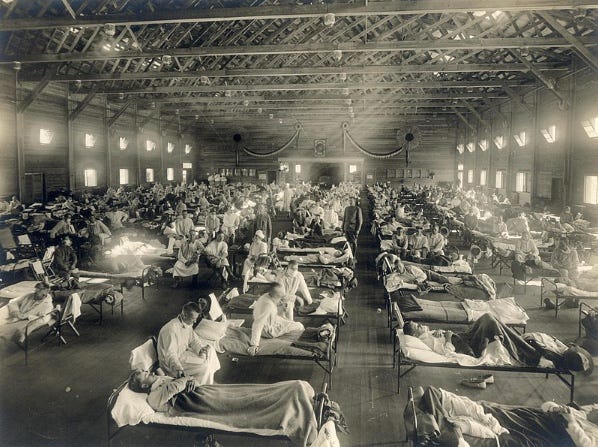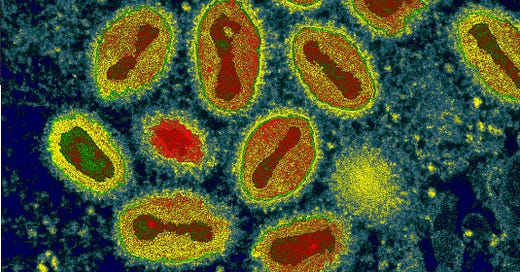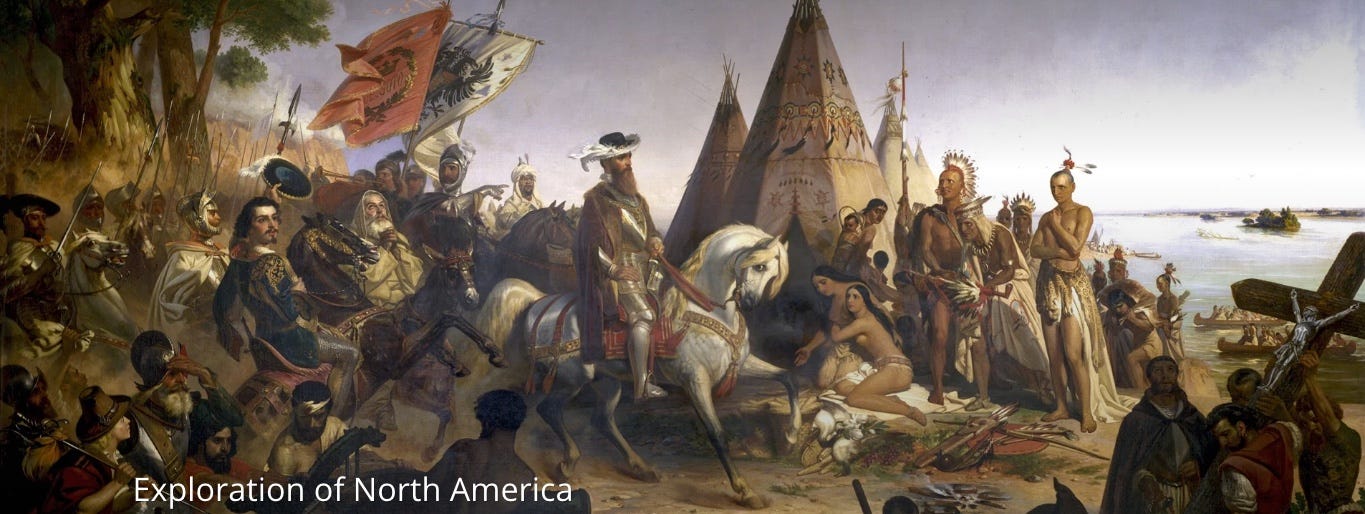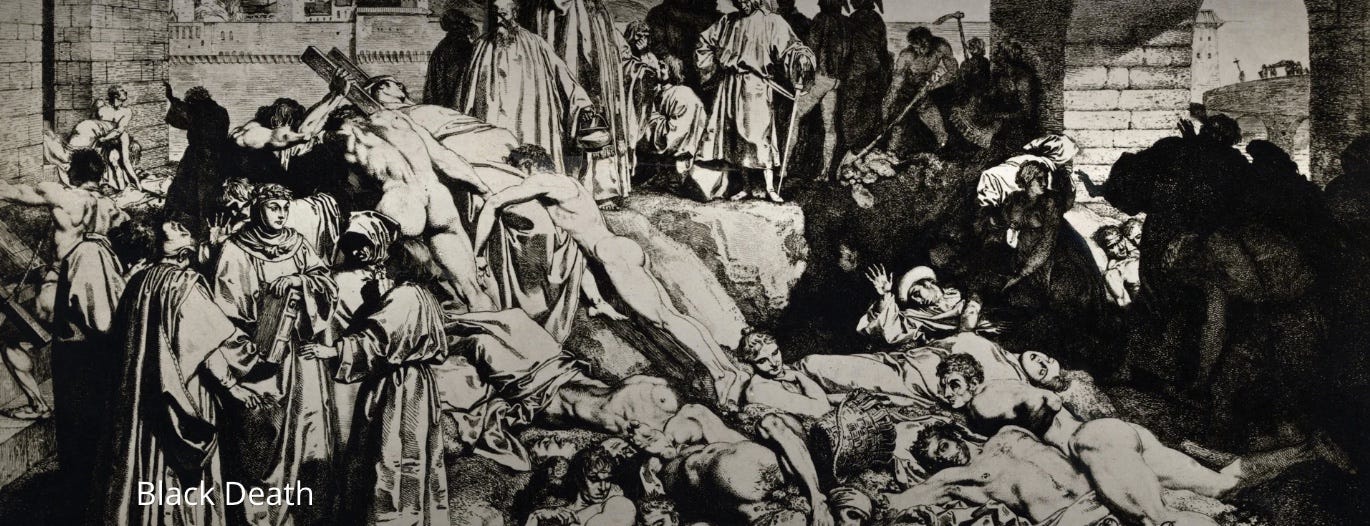Ever since history has been recorded, pandemics have visited their destructive power on humanity - viruses and bacteria running amok, crossing borders, seas, mountain ranges, empires, and killing massive amounts of people.
Smallpox, one of the most pernicious, is (or was, it has now been eradicated following a global vaccination campaign led by the World Health Organization) a tiny little virus that managed to kill between 300-500 million people during its long rampage thru the annals of history.

Then there’s the Spanish Flu of 1918 which killed 50 million people. First observed in Europe, the United States and parts of Asia, it swiftly spread around the world facilitated by the massive troop movements after the First World War. There were no effective drugs or vaccines at the time to stop it. By the summer of 1919 the threat had dissipated mostly because the infected people had either died or developed immunities and then we quickly forgot about it.

HIV/AIDS was first identified in American gay communities in the eighties. It is believed to have jumped from chimpanzees to humans sometime back in the twenties in West Africa. AIDS destroys a person’s immune system, resulting in eventual death by diseases that the body would normally fight off. People infected with the HIV virus have fever, headaches, and enlarged lymph nodes. When the symptoms subside, they are still highly infectious through blood and genital fluid.
Treatments have been developed to slow the progress of the disease, but 35 million people worldwide have died so far and a cure is not yet available.
A smorgasbord of plagues and pandemics known simply as the Columbian Exchange followed the arrival of Columbus in the Caribbean. Smallpox, measles, whooping cough, chicken pox, bubonic plague, typhus, and malaria - all diseases for which the ‘New World’ people had no immunity decimated the native population. It’s estimated that 90% of the New World population succumbed to these diseases within 100–150 years of Columbus’ arrival, destroying cultures that had existed for thousands of years in the process and making conquest much easier for the invading Europeans.
Of the estimated 250,000 natives in Hispaniola, Columbus' first stop in the Americas in 1492, new infectious diseases wiped out a staggering 236,000 indigenous people by 1517 - nearly 95% of their population. In the Aztec capital of Tenochtitlan, later known as Mexico City, forty percent of the 200,000 people who were living there are estimated to have died of smallpox in 1520 during their war with Cortés and his army. The indigenous population of Peru decreased from about 9 million in the pre-Columbian era to 600,000 in 1620. The same devastation happened among the natives in North America
The Black Death was a pandemic that occured in Europe, Asia and Africa between 1346 and 1353. It’s responsible for more deaths than any other pandemic in recorded history: 75–200 million people. It’s also called the Bubonic plague and is spread by fleas carried by rats and also can be spread person to person thru the air. So many people died from this disease that it took Europe 200 years to regain its pre-plague population level. Outbreaks of the plague kept recurring around the world until the early 19th century.
In fact the Bubonic plague had attacked Europe before. From AD 541-542 it killed 25 million people, approximately half the population of Europe. Known as the Plague of Justinian it was centered in the Byzantine Empire and Mediterranean port cities. At its height the city of Constantinople was losing 5,000 people a day, eventually resulting in the reduction of its population by 40%.
The cheery news is that plagues and pandemics continue to haunt us, they’re not a thing of the past. We’re in the midst of one right now that has killed off 6 million people in virtually every corner of the world - and with all our modern medicines, vaccines, hospitals and doctors. What are we to make of all this?
Maybe the bugs are trying to tell us something, is what I make of it. We live in a microbial world. The first 3 billion years of life on this planet was all microbial. Did you know that? It was just a lot of tiny little life entities of various species floating around in a watery world (the oceans) learning how to survive and adapt, how to communicate and collaborate. In fact communication and collaboration were their main strategies for survival. It has been suggested, I think it was by Lewis Thomas in his brilliant book ‘The Lives of a Cell’, that pathogenic microbes (the ones that make us sick) are nothing more than a failed attempt at collaboration.
They learned how to merge into each other (endosymbiosis) and create a larger more sophisticated cells (eukaryotic cells). Viruses gained the ability to hijack the DNA replication machinery inside the cell’s nucleus to make copies of themselves (since they can’t self replicate) and in the process shared snippets of DNA code with other cells, essentially speeding up the occurrence of mutations and hence evolution. There’s a new twist.
We live in a microbial world but we can’t see them so we don’t talk about them. Until we get sick. Then it’s about how can we kill the miserable little bastards. I’d like to suggest that we introduce ourselves and make friends with them. Of the trillions of microbes that inhabit our gut, our skin and our mouth most of them are mutualistic (actively benefiting us) or commensal (neutral).
My own personal experiments have produced evidence that the little people (what I call the gut microbes) influence my dreams. If I’m off diet my dream, that I usually remember just before waking up, is kind of strange or really strange or kinda strange and kinda good depending on how off my diet I’ve been. When I’m on my diet and they seem content and peaceful, my dreams are wonderful. I’m not kidding, this is my consistent experience. They are able to talk to us thru the vagus nerve which is attached to our medulla oblongata at the base of our brain by using human cells in our gut lining as intermediaries (enteroendocrine cells) that produce neuroactive molecules.
So my point is maybe we need to recognize and accept the little people as the first inhabitants of this planet and the basis of all life and hold them in a higher regard than we normally do. Maybe they just want a little respect. They may live for only a few hours or a few days but their lineage goes way back much further than ours. Multicellular organisms are a relatively recent development. We are not nearly as good at collaboration or communication as they are.
A hard thing to admit perhaps. Humans with our big egos don’t want to be trumped by a microbe. Of course we are smarter. But the truth is whenever a mass extinction event happens, as it has at least 5 times in the past, nature regresses back towards simpler life forms. If the extinction is massive enough, say a nuclear holocaust, it could regress all the way back to microbes, the basic building blocks of life, the simple self-replicating organisms that live at the bottom of the food chain. In that case the microbes would act as a repository for the genetic information that forms the basis of life here on earth. Otherwise it would be possible that our planet could return to a barren state with no life at all. Thank you microbes.
Microbes are in the air, in the dirt, in the water and in our bodies. They’re everywhere. I salute the mighty microbe. To quote Men in Black - ‘Just because it’s very small doesn’t mean it’s not very important’. In that movie there was a whole world living on a marble that you could hold in your hand and in fact our whole world turned out to be a marble someone else was holding in their hand. That’s how the movie ended as I recall. Marbles within marbles, worlds of different magnitudes.
We don’t know much about the ultra-macro scale or the ultra-micro scale. We live somewhere in between on our little marble oblivious to what’s outside our ‘universe’ or inside our tiniest speck of reality whether it’s called a quark or a string or a boson. We think we’re the boss. We think we’re in control. Until the microbes show up.
music :: a great playlist from Cafe De Anatolia
please sign up if you like this newsletter
let me know what you think
share this with a friend

















Share this post